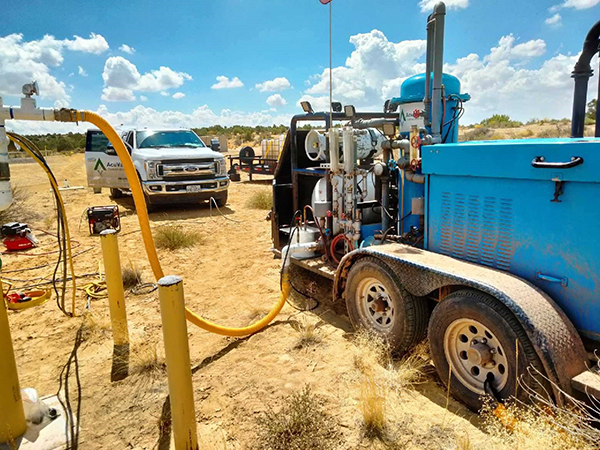Getting to Clean: High-Resolution Data Dials in Remediation Process
Published on by Marcus Miller, Digital Marketing Manager at In-Situ in Case Studies

Getting to Clean: High-Resolution Data Dials in Remediation Process
Overview
For each project, AcuVac Remediation must determine the best methodology to effectively remove volatile organic compounds (VOCs) from groundwater and soil while minimizing disturbance to the water table.
Challenge
Houston-based AcuVac Remediation receives calls reporting contamination from a wide range of sources–from oil fields to leaking pipelines and gasoline storage tanks. Untreated, these leaks can pollute aquifers and flow into freshwater drinking sources, threatening public reservoirs, private wells and water supplies for agriculture and livestock.
But groundwater remediation is complicated. Without highly-accurate measurements, the extent and location of the contamination remains a mystery until water is pumped above ground.
AcuVac follows a process called Mobile Dual Phase Extraction (MDPE), using a powerful vacuum to draw contaminants into one consolidated location before pumping the contamination layer up to the surface for treatment.
MDPE is much faster and more effective at removing contaminants, but the force the vacuum exerts during pumping could stress the aquifer if equipment isn’t positioned carefully. The most common VOCs, like oil and diesel, float on top of the water table, so AcuVac monitors water quality and level to find the ideal position for their pumps–as close as possible to the interface between fresh groundwater and the contamination layer.
Without accurate level measurements, pumps could remove clean groundwater, wasting a precious resource and causing additional stress to the water table. Highly accurate level measurements are essential to correctly identify the product-water interface and minimize pumping.
AcuVac also needs reliable data on water quality to prepare effective treatment for the contaminated groundwater when it reaches the surface. “You have to have extremely precise and reliable equipment that can tell you what you’re dealing with before pumping it out,” says Lisabeth Abrams, AcuVac’s Vice President of Business Development.
Solution
AcuVac uses a combination of In-Situ water quality and level monitoring instrumentation to identify the presence and location of contamination, position equipment effectively, and assess changes in water quality and level throughout the remediation process.
The Level TROLL 700 records high-resolution data on level, pressure and temperature, helping AcuVac get pumps as close as possible to the layer of VOCs above the groundwater.
“Before In-Situ, we were just kind of guessing how close we were to the product-water interface,” says AcuVac President Paul Faucher.“Once we started using the Level TROLL 700s, we could dial in within a foot and a half of that interface. Before that, we were just flying blind.”
Level data not only helps minimize disturbance to the water table, but also improves project efficiency. “It allows us to be a lot more effective for our clients because their key metric is the cost per gallon to remediate the contamination,” says Faucher.
The powerful vacuum required to pump out contamination can interfere with the accuracy of level measurements, but by attaching the Level TROLL to VuLink telemetry with a vented cable, AcuVac is able to equalize the vacuum and get accurate readings. Ten different lengths of vented cables allow AcuVac to adapt to the depth of wells at different sites.
AcuVac also uses VuLink telemetry to monitor the impact of pumping on outer wells at their sites. They place telemetry devices in wells between 10 and 50 feet away for real-time updates on how the process is affecting the hydraulic gradient. “We’re really happy with the VuLinks,” says Faucher, reporting higher efficiency because they can receive and monitor data transmissions from several wells at once.
AcuVac’s projects span the southern United States; they serve clients in Mississippi, Louisiana, Oklahoma, Texas and New Mexico, which means it can take days to travel to a site from their Houston headquarters. That large geographic area makes it even more important to have equipment that’s easy to set up and use, to save time and effort wherever possible. “These things need to work right out of the box,” says Abrams. “They need to be easy to calibrate and to start working with. And In-Situ is just beautiful in that arena.”
The southern United States experiences extreme temperatures, especially in summer. Faucher adds that having a level instrument that also reports temperature is key. Typical pumps can only handle water up to 85 degrees Fahrenheit and some of AcuVac’s sites get so hot in the summer that the temperature of shallow wells reaches between 85 and 90 degrees. Having a temperature gauge is essential to select the right pumps and prevent damage to the equipment.
AcuVac also uses the Aqua TROLL 400 to monitor dissolved oxygen (DO), oxidation reduction potential (ORP) and other water quality parameters during air sparging, another remediation method. Air sparging involves injecting air below the water table to volatize VOCs, concentrating any dispersed contaminants at the surface of the groundwater interface to minimize pumping. AcuVac takes DO readings before the test, then every 30 minutes after air injection to ensure the process is working effectively.
Results
AcuVac has gained recognition for their...
READ MORE
Taxonomy
- Water Quality
- Groundwater
- Hydrodynamics & Water Quality
- Water Quality Management
- Water Quality Training
- Groundwater Recharge
- Groundwater Assessment
- Groundwater Modeling
- Groundwater Pollution
- Groundwater Prospecting
- Groundwater Mapping
- Soil & Water Assessment Tools
- Groundwater Salinisation
- Water Quality Monitoring
- Remediation
- Groundwater Resource
- Water Quality Monitoring
- Water quality
- Groundwater flux
- Remediation
- Water Quality Research
- Groundwater monitoring and assessments
- Groundwater Remediation
- Groundwater Data Scientist
- water remediation
- Water Quality Monitoring Sensor
- Water Quality